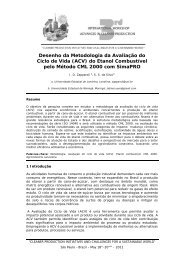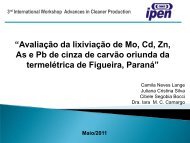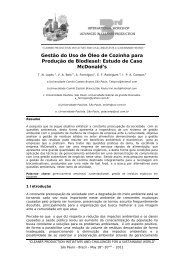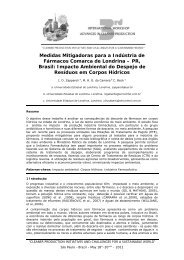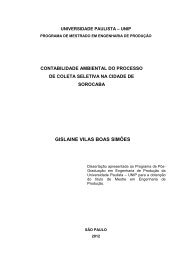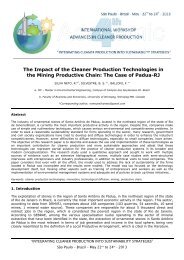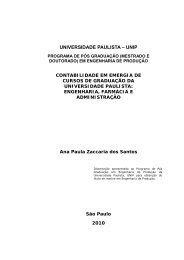Emergy as a tool for Ecodesign - Advances In Cleaner Production
Emergy as a tool for Ecodesign - Advances In Cleaner Production
Emergy as a tool for Ecodesign - Advances In Cleaner Production
You also want an ePaper? Increase the reach of your titles
YUMPU automatically turns print PDFs into web optimized ePapers that Google loves.
C.M.V.B. Almeida et al. / Journal of <strong>Cleaner</strong> <strong>Production</strong> 18 (2010) 32–43 37<br />
Fig. 5. Energy diagram <strong>for</strong> PET-R production using virgin and recycled materials. Each number within the circles or over arrows corresponds to a line in Table 3. <strong>Emergy</strong> fluxes 5, 10,<br />
14, 18 and 22 are presented in the table but do not contribute to the total emergy, <strong>as</strong> the only raw material entering the production chain is crude oil.<br />
emergy yield driving the process h<strong>as</strong> been calculated (Tables 2, 3, 4<br />
and 5) a set of indices and ratios can be accordingly calculated.<br />
<strong>Emergy</strong> indices have been shown to be particularly useful when<br />
studying processes under human control, where a sustainable<br />
pattern is not guaranteed and choices have to be supported by the<br />
careful consideration of many different parameters. The environmental<br />
loading ratio (Eq. (1)) expresses the use of environmental<br />
services by a system, indicating a load on the environment. The<br />
Table 2<br />
Environmental accounting <strong>for</strong> the PET bottle production (500 bottles).<br />
# Item a Type Unit Amount <strong>Emergy</strong> per<br />
unit d (sej/un)<br />
Solar <strong>Emergy</strong><br />
(sej)<br />
Oil extraction<br />
1 Water R g 9.49 10 4 2.03 10 5 1.93 10 10<br />
2 Electricity F J 1.69 10 9 1.65 10 5 2.79 10 14<br />
3 Diesel (transport) F J 5.16 10 8 6.60 10 4 3.41 10 13<br />
4 Crude oil N J 2.30 10 9 5.54 10 4 1.27 10 14<br />
5 Petroleum Y1 g 7.46 10 4 5.90 10 9 4.41 10 14<br />
Refining<br />
6 Water R g 4.33 10 4 2.03 10 5 8.79 10 9<br />
7 Electricity F J 2.27 10 9 1.65 10 5 3.74 10 14<br />
8 Diesel (transport) F J 4.51 10 8 6.60 10 4 2.98 10 13<br />
9 Methanol F J 2.07 10 8 4.80 10 4 9.93 10 12<br />
10 DMT þ MEG b Y2 g 3.29 10 4 2.60 10 10 8.55 10 14<br />
Resin production<br />
11 Water R g 5.54 10 3 2.03 10 5 1.12 10 9<br />
12 Electricity F J 1.89 10 8 1.65 10 5 3.12 10 13<br />
13 Diesel (transport) F J 1.19 10 8 6.60 10 4 7.82 10 12<br />
14 PET Resin Y3 g 2.60 10 4 3.44 10 10 8.94 10 14<br />
Pre<strong>for</strong>m c production<br />
15 Water R g 1.96 10 3 2.03 10 5 3.98 10 8<br />
16 Electricity F J 1.47 10 7 1.65 10 5 2.43 10 12<br />
17 Diesel (transport) F J 4.52 10 7 6.60 10 4 2.98 10 12<br />
18 Pre<strong>for</strong>mer Y4 g 2.39 10 4 3.76 10 10 8.99 10 14<br />
PET bottle production<br />
19 Water R g 4.50 10 4 2.03 10 5 9.14 10 9<br />
20 Electricity F J 1.60 10 8 1.65 10 5 2.64 10 13<br />
21 Diesel (transport) F J 1.06 10 7 6.60 10 4 6.98 10 11<br />
PET bottles Y g 2.50 10 4 3.70 10 10 9.26 10 14<br />
a Items from lines 5, 10, 14 and 18 (over arrows in Fig. 4) were not accounted to<br />
avoid double-counting.<br />
b DMT dimethyl terephtalate and MEG mono ethylene glycol.<br />
c <strong>In</strong> the PET bottle life cycle, the PET resin is first molded into a ‘‘pre<strong>for</strong>m’’ using<br />
the <strong>In</strong>jection Molded Process. These pre<strong>for</strong>ms are produced with the necks of the<br />
bottles, including threads on one end. These pre<strong>for</strong>ms are fed after cooling into<br />
a blow molding machine.<br />
d The values of emergy per unit calculated in this table (lines 5, 10, 14 and 18) only<br />
take into account inputs considered in the LCI used (water, electricity and diesel <strong>for</strong><br />
transport). However, the value calculated <strong>for</strong> PET resin is comparable to that<br />
calculated <strong>for</strong> PVC (1.14 10 10 sej/g [76]), confirming that the inputs considered are<br />
the main flows of PET production.<br />
Table 3<br />
Environmental accounting <strong>for</strong> the PET-R bottle production, 40% of recycled material<br />
in weight (500 bottles).<br />
# Item a Type Unit Amount <strong>Emergy</strong> per<br />
unit (sej/un)<br />
Solar emergy<br />
(sej)<br />
Oil extraction<br />
1 Water R g 5.69 10 4 2.03 10 5 1.16 10 10<br />
2 Electricity F J 1.01 10 9 1.65 10 5 1.67 10 14<br />
3 Diesel (transport) F J 3.10 10 8 6.60 10 4 2.04 10 13<br />
4 Crude oil N J 1.38 10 9 5.54 10 4 7.65 10 13<br />
5 Petroleum Y1 g 4.48 10 4 5.90 10 9 2.64 10 14<br />
Refining<br />
6 Water R g 2.60 10 4 2.03 10 5 5.28 10 9<br />
7 Electricity F J 1.36 10 9 1.65 10 5 2.25 10 14<br />
8 Diesel (transport) F J 2.71 10 8 6.60 10 4 1.79 10 13<br />
9 Methanol F J 1.24 10 8 4.80 10 4 5.96 10 12<br />
10 DMT þ MEG b Y2 g 1.97 10 4 2.60 10 10 5.13 10 14<br />
Resin production<br />
11 Water R g 3.32 10 3 2.03 10 5 6.75 10 8<br />
12 Electricity F J 1.13 10 8 1.65 10 5 1.87 10 13<br />
13 Diesel (transport) F J 7.11 10 7 6.60 10 4 4.69 10 12<br />
14 PET Resin Y3 g 1.56 10 4 3.44 10 10 5.36 10 14<br />
Recycling<br />
15 PET bottles (after use) g 1.14 10 4<br />
16 Water R g 1.50 10 4 2.03 10 5 3.05E 10 9<br />
17 Electricity F J 1.02 10 8 1.65 10 5 1.68 10 13<br />
18 Diesel (transport) F J 1.09 10 7 6.60 10 4 7.17 10 11<br />
19 Recycled PET Resin Y4 g 1.04 10 4 5.32 10 10 5.54 10 14<br />
Pre<strong>for</strong>m production<br />
15 Water R g 1.96 10 3 2.03 10 5 3.98 10 8<br />
16 Electricity F J 1.47 10 7 1.65 10 5 2.43 10 12<br />
17 Diesel (transport) F J 4.52 10 7 6.60 10 4 2.98 10 12<br />
18 Pre<strong>for</strong>mers Y5 g 2.39 10 4 2.34 10 10 5.59 10 14<br />
PET bottle production<br />
19 Water R g 4.50 10 4 2.03 10 5 9.14 10 9<br />
20 Electricity F J 1.60 10 8 1.65 10 5 2.64 10 13<br />
21 Diesel (transport) F J 1.06 10 7 6.60 10 4 6.98 10 11<br />
PET-R bottles Y g 2.50 10 4 2.34 10 10 5.86 10 14<br />
a Items from lines 5, 10, 14, 18 and 23 (over arrows in Fig. 5) were not accounted<br />
to avoid double-counting.<br />
b DMT dimethyl terephtalate and MEG mono ethylene glycol.




